Why Germany needs international software developers?
Where there is progress, there is appetency. To sustain its momentum, there is a constant need for International Software Developers in Germany, advances in technology, and growth. The demand for skilled professionals persists, highlighting the appetite for excellence in its ever-evolving landscape. Let’s delve into the origins of this rising pattern.
- Innovation: Innovation is the currency of development. Germany recognizes this truth, yet faces a pressing challenge of a scarcity of skilled software developers within its domestic talent pool. Germany stands at a crossroads. This scarcity doesn’t solely affect specific sectors but the entire economy. A shortage of software developers can limit industries’ ability to develop new products, enhance existing technologies, or stay ahead of competitors in rapidly evolving markets.
The demand for software developers in Germany across multiple sectors has drastically increased. Software development isn’t just for tech companies anymore. Industries like healthcare, finance, manufacturing, and retail need software to improve how they work and serve customers.
- Digitalization: Digitalization reshapes the way companies or businesses operate and interact with users. This transformation is particularly evident in Germany, where the IT market is estimated to achieve a value of $129 billion by 2025.
With the evolution of the digitization industry, the demand for tech talent, especially in software development, has skyrocketed.
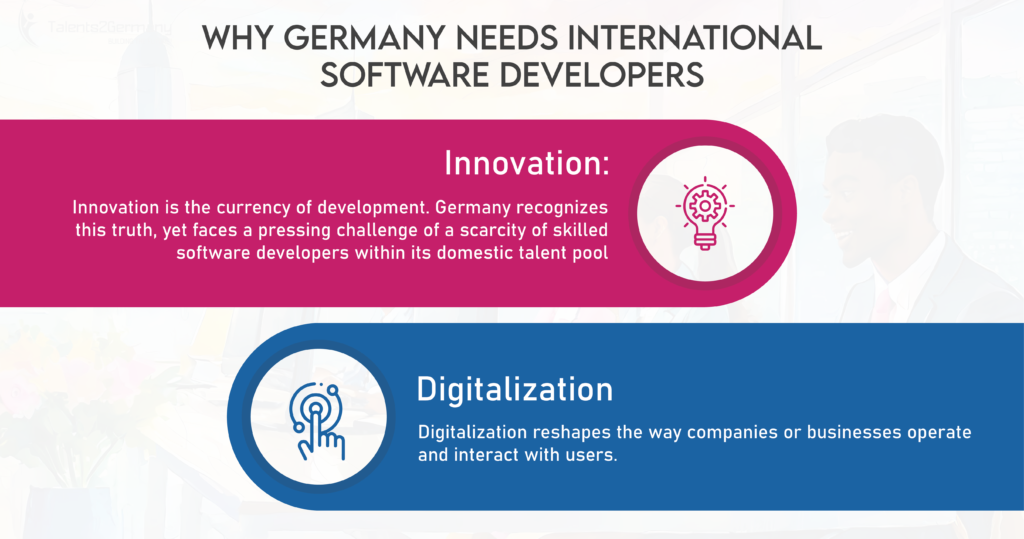
Recruiting international software developers isn’t merely an option; it’s a necessity to sustain and advance Germany’s position as a leader in technology and innovation.
The gap in STEM education in Germany
The quest for engineering expertise reflects the changing dynamics of education and demographics. The relationship between industry demands and educational systems is interconnected.
When industries face shortages in qualified personnel, it often signals a concerning trend. Interest in STEM university degrees has fallen, with a 6% drop in one year according to federal statistics.
This decline in interest or investment in education in these areas is below.

The image shows statistics for new enrollments in MINT subjects in Germany (STEM in English), which include engineering, informatics (computer science), mathematics, and natural sciences for the first university semester. The numbers indicate a declining trend in enrollments over recent years:
- In the academic year 2016/2017, there were 54,514 enrollments in engineering/informatics and 143,374 in mathematics/natural sciences in Germany.
- By 2021/2022, enrollments decreased to 49,613 in engineering/informatics and 122,354 in mathematics/natural sciences in Germany.
Meanwhile, according to the UNESCO Institute of Statistics by 2023:
- India has a high share of 34% of students picking STEM, producing the most graduates in total in the field due to its population of around 1.4 billion people.
- Students in Malaysia and Tunisia are among the most likely to graduate in a STEM field.
- Other countries with a strong showing of STEM graduates are the United Arab Emirates, Belarus, and South Korea and Germany is equal to them – all producing more than 30% STEM graduates.
The gap in the STEM workforce in Germany
Meeting Demand: As of 2023, over 149,000 unfilled IT roles are due to a need for qualified individuals. This shortage indicates a mismatch between employers’ demand for STEM professionals and the available supply of workers with the necessary skills and qualifications in Germany’s labor market.
The statistics show a significant increase from 28,000 in 2009.

The employment dynamic is particularly strong among immigrants but without success in immigration, there would be an additional shortage of around 413,800 STEM specialists according to STEM Report 2023 by the Cologne Institute for Economic Research.
Boosting the Economy: The shortage underscores the importance of addressing workforce gaps to sustain economic growth. By addressing workforce gaps, Germany can position itself for sustained economic growth and prosperity in the long term. A skilled workforce attracts investment from both domestic and international companies, bolstering economic activity and job creation.
The number of open IT positions in Germany’s economy and the percentage of companies experiencing a shortage of IT professionals:
- In 2015, there were 43,000 open positions, with 55% of companies noting a lack of IT experts.
- By 2020, open IT positions increased to 86,000, with 70% of companies reporting a shortage.
This trend highlights the growing gap between the supply and demand of IT professionals in Germany.
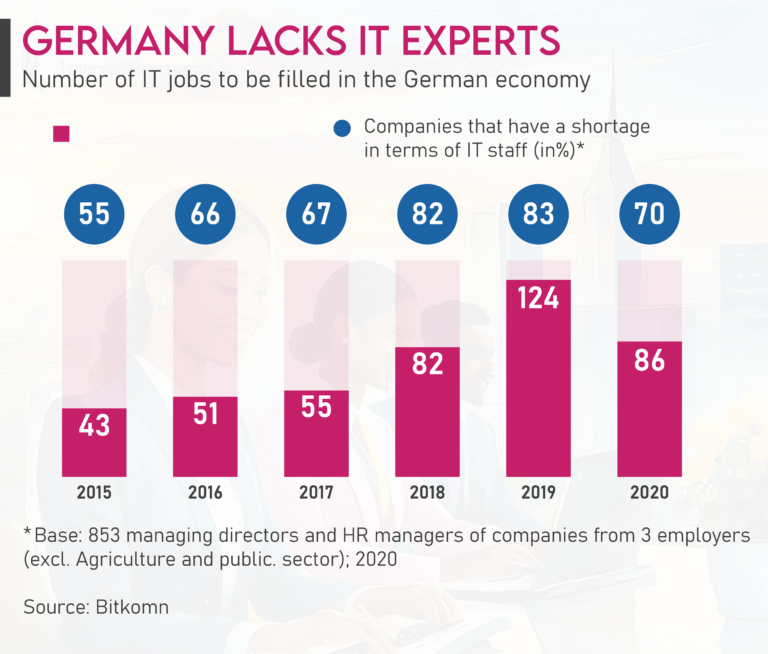
How do tech skills problems affect German industries?
It’s straightforward that tech skills shortages have a profound impact not only tech field but also on industries, on other sectors, affecting their ability to innovate, and compete.
For instance, in the healthcare sector, the lack of specialists can impede the development of innovative medical technologies, such as telemedicine platforms or diagnostic tools.
Similarly, in the finance industry cybersecurity can leave financial institutions vulnerable to cyberattacks, compromising sensitive customer data and eroding trust.
What are the challenges German employers face due to a shortage of software developers?
- Limited candidates
The scarcity of skilled candidates makes it difficult for employers to find the right fit for their open roles. It leads to extended hiring timelines and delays recruitment procedures in project schedules. Having a larger pool of candidates to choose from is advantageous.
- Expertise Mismatch
Employers face significant challenges in sourcing candidates with the precise skill sets essential for their projects. This scarcity often leads to compromises in project scope.
What do you think should be the decision?
In many cases, the implementation of upskilling programs to bridge the gap between desired and available skill sets or consider alternative strategies such as adjusting project requirements. Many companies have started investing in training initiatives to mitigate skill deficiencies and ensure successful project execution.
- Outsourcing
While outsourcing can offer cost savings and access to specialized expertise, it also introduces risks such as data security concerns, communication barriers, and quality control issues. Managing remote teams across different time zones and cultures can be challenging. The company also should adjust remote job salaries in Germany mainly due to legal considerations, training needs, and loyalty factors compared to onsite positions. For further insights on remote work, refer to Remote vs Onsite Jobs in Germany: Key Pros & Cons by Talents2Germany.
Companies need to invest time and resources to identify trustworthy outsourcing partners, create effective communication channels, and set clear expectations.
Global potential: an international comparison
Impact of demographics on the workforce
With an aging population, Germany faces unique challenges and opportunities in various sectors, including labor markets.
Approximately 19% of the workforce in Germany aged 40-59 is estimated to retire in the next 10 years. 40-59-year-olds comprise the largest age group in Germany, at 23 million people. The most recent figures from 2022 confirm that the next-largest age group was 65 years and older, at 18.66 million.
Add visual of the demographic distribution in Germany.
Retirement Wave: Germany debates raising the retirement age to 70 to address an aging population and labor shortages, challenging the sustainability of its pension system. Germany stands out as one of the oldest countries globally, boasting a median age of 47.1 years. This demographic distinction reflects a population structure characterized by a significant proportion of elderly individuals relative to younger age groups.
World map indicating the median age in various regions for the year 2020, with projections for 2100. It shows:
- Monaco has the highest median age at 53.1 years.
- Afghanistan is the youngest non-African country.
- Japan has a significantly higher median age than the rest of Asia at 47.3 years.
- By 2100, nearly half of the world’s children aged 0-4 will live in Africa.
- Median ages for select countries in 2020: Canada 42.2, USA 38.1, Mexico 28.3, Belize 22.7, and Guatemala 22.1.
The map also highlights future population estimates, showing that by 2100, Sub-Saharan Africa will have a significantly larger youth population compared to the rest of the world.
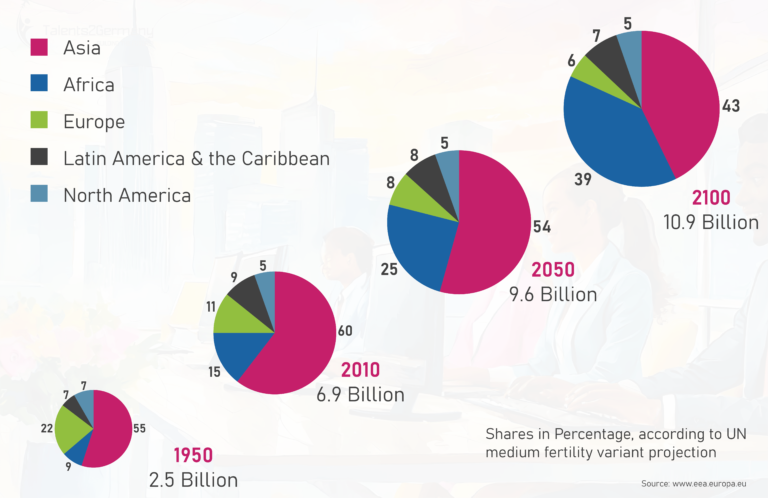
Youthful advantage: Africa’s path
In stark contrast, several African countries on the graph below, such as Niger, Mali, Uganda, Angola, and Zambia, have some of the world’s youngest populations, with median ages ranging from 15.4 to 16.8 years. This youthful demographic presents an opportunity for these nations to capitalize on the energy, creativity, and potential of their young populations to drive economic growth and development.
WANT TO MIGRATE PROFESSIONALLY
TO GERMANY?

Median age:
- The youngest countries include Niger (15.4), Mali (15.8), Uganda (15.8), Angola (15.9), and Zambia (16.8).
- The oldest countries are Monaco (53.1), Japan (47.3), Germany (47.1), Italy (45.5), and Slovenia (44.5).
The population pyramid for Africa in 2023 shows a large young population and tapering numbers as age increases, reflecting fewer elderly individuals.
The distribution between male (in blue) and female (in red) populations across different age groups, from 0 years at the bottom to over 100 years at the top.
The widest part of the pyramid is at the bottom, indicating a large young population, with numbers tapering off as age increases, showing fewer elderly.

- Conversely, Africa’s youthful population represents a potential source of talent that can contribute to Germany’s IT workforce and economic development.
IT potential of African countries
Across various African countries, the number of professional developers is rising, reflecting the region’s growing tech talent pool.
With this data in mind, employers can strategically navigate their choices and targets to find the skilled talent they need to stay competitive in today’s dynamic market.
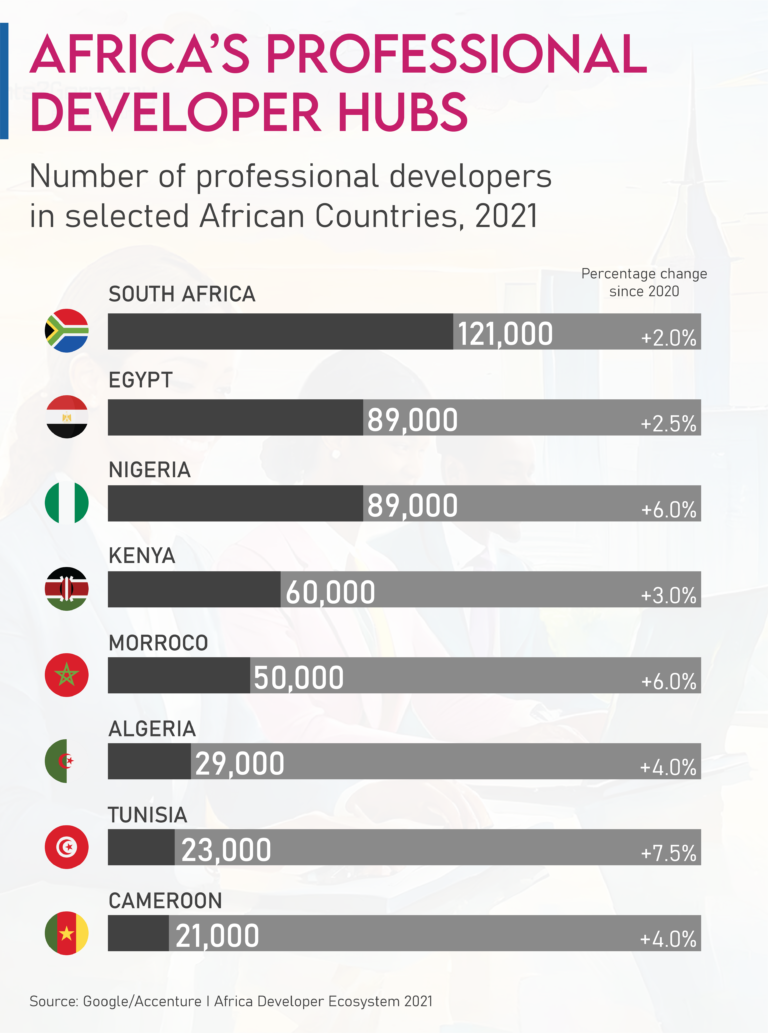
The increasing number of software developers globally
As demand for digital solutions continues to rise, the contributions of software developers across different nations are essential for fueling economic growth on a global scale.
According to recent data, software developers are abundant globally, with China leading the pack at 7 million professionals, followed closely by India with 5.8 million.
Statista predicts that the number of developers worldwide will increase by 3.2 million by 2024. Most of this increase is likely to happen in China, where the number of developers is expected to grow by 6% to 8% in 2024.
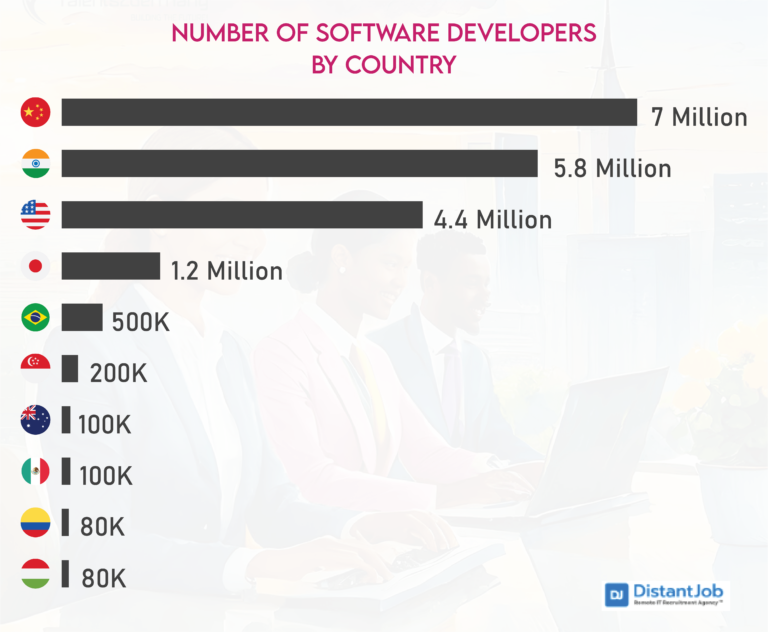
Which country offers the highest salary for software engineers?
The United States proudly holds the top position for paying software engineers the highest salaries among all countries. This comes as no surprise, given the exceptional opportunities and benefits available in the nation often referred to as the land of opportunity.
On the other hand, the average base salary for a software engineer in Europe per month can range from $54k to $109k.
When considering these salary figures, it’s essential to contextualize them to the cost of living in each respective country. Factors such as housing expenses, healthcare costs, and general affordability play a significant role in determining the true purchasing power of these salaries. Also, net quality of living takes into account not only the salary but also factors such as work-life balance and overall well-being.
Meet here for more details: Navigating Life in Germany: Salary, Tax-Deductions & Cost of Living
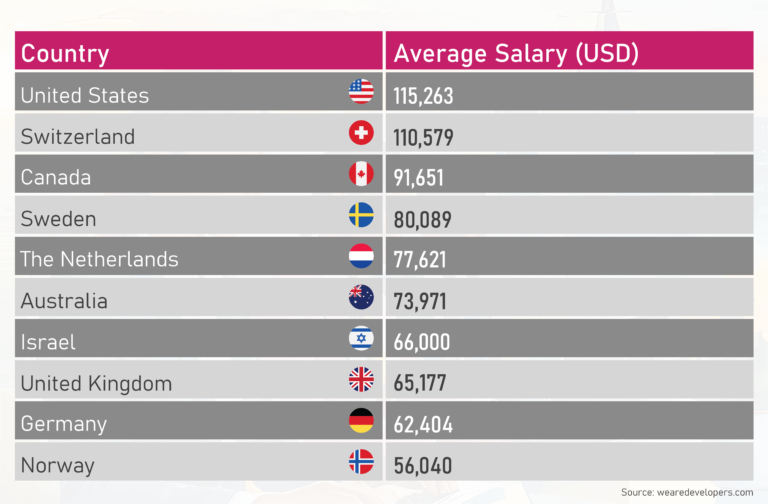
What about the Asia region?
Singapore has become a prominent tech hub in Southeast Asia, boasting advanced infrastructure and a diverse population. This environment attracts leading tech firms and offers software engineers opportunities to engage in innovative projects.
Software engineers in Vietnam can get good pay: the country is supportive of new startup companies, which makes it even more appealing for software engineers.
In contrast, if we compare these figures to software developer salaries in countries like India, where ages are traditionally lower, the difference is stark.
German government and industry actions
Opening doors for global talent
Efforts are currently underway in Germany to streamline immigration processes, particularly for skilled labor, aiming to position the country as an attractive destination for global talent.
Recognizing the importance of skilled professionals in driving innovation and sustaining economic growth, policymakers have initiated measures to simplify visa procedures and speed up the process of work permits for highly skilled individuals, particularly in STEM fields.
Take your time to read The New Immigration Law Germany article, and get to know how Germany easing barriers to entry for talented professionals.
Apart from the law changes, Germany has ambitious green projects, aimed at achieving sustainability and reducing environmental impact, which drive the need for International Software Developers in Germany in various engineering sectors.
What is the extent of foreign investment in Germany’s IT sector?
Foreign direct investment (FDI) in Germany primarily comes from European countries, the United States, and Japan, although there has been an increase in investment from emerging economies in recent times. The United States stands out as the primary source of non-European FDI in Germany.
From 2020 to 2021, there was a notable surge in U.S. FDI in the IT sector, rising from $5.3 billion to $12.6 billion. Traditionally, sectors such as machinery, finance, information technology, holding companies (nonbank), and professional, scientific, and technical services have been the focal points of U.S. FDI in Germany. (source) In the case of a partnership with India, more than 213 Indian companies are operating in Germany. Investments are mostly in IT, automotive, pharma, biotech and manufacturing.
Foreigner integration in Germany
In the past ten years, slightly more than 6 million individuals relocated to Germany, according to records spanning from 2013 to 2022.
The share of Indians within Germany’s overall foreign population rose from 0.7 percent to 1.6 percent during the last 10 years.
What is the solution?
How can a candidate drive change?
It is a great open window for you.
- Brush up Skills and Qualifications: Refine your tech skills and understand the German tech industry’s needs. Invest time enhancing your technical skills and qualifications to remain competitive in today’s fast-paced tech industry. Seek feedback, engage in self-assessment, and adapt your learning strategies to stay at the forefront of technological advancements. Explore online courses, workshops, and certifications tailored to your areas of interest and career goals.
- Stay updated: Stay updated with the latest trends. Engage with industry-specific content: it will help to stay abreast of emerging technologies and market demands.
- Cultural Integration: Familiarise yourself with German work culture to fit in better with your new surroundings. Improve your skills in German to enhance communication with colleagues and clients.
- Join a program such as Talents2Germany: The demand for software engineers continues to rise, so let us bridge the gap for you. With our expertise and extensive industry connections, we’ll guide you every step of the way, from securing the perfect job match to navigating the relocation process smoothly. You can make a change as a candidate with us.
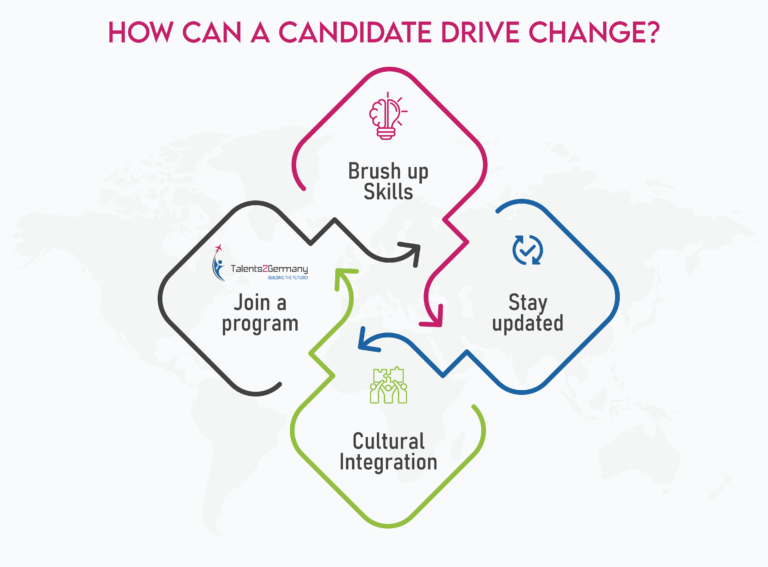
Future projections on the rising demand for global software talent in Germany
Looking ahead, the shortage of skilled professionals in software development and IT is likely to escalate. Among the factors is the aging workforce, where experienced professionals retire, leaving gaps in expertise. Also, there’s a concerning trend of declining interest among young individuals in pursuing careers in STEM. On top of that, the fast-paced changes happening in different industries mean there’s a growing demand for software developers and IT experts. As Germany becomes an even bigger tech hub in Europe, the need for skilled workers will only increase. It’s important for initiatives to be put in place to address this skills gap and encourage more people to pursue careers in these fields.
The need for software engineers is expected globally to skyrocket by 22% from 2020 to 2030, which is way faster than most other jobs.
Specifically, in Germany, expectations forecast an annual growth rate of 4.16% in the software development market from 2023 to 2028.
- Aging IT Workforce: In Germany, 37% of all IT experts are over 50 years old, according to 2022 data from the Federal Office for Statistics. As earlier mentioned, 40-59-year-olds make up the largest age group in Germany, at 23 million people. The most recent figures from 2022 confirm that the next-largest age group was 65 years and older, at 18.66 million. As soon as this experienced IT cohort quit their jobs in the upcoming decade in large numbers; the German IT sector is likely to face massive skills shortages in important fields. It is predicted that around one-fifth of Germany’s workforce will have retired by 2030. Therefore, the country is tasked to focus on both recruiting new sources of tech talent domestically and drawing people from elsewhere abroad. If recruiting people from elsewhere is neglected, it poses the greatest threat to the German economy in terms of competitiveness and digital progress.
- Needs for emerging technologies: As new technologies emerge, skills requirements also evolve alongside. As a result, software developers with expertise in artificial intelligence, machine learning, cybersecurity, cloud computing, and the Internet of Things (IoT) are in high demand. Despite this, only 20% of German companies report finding sufficient talent in these areas.
- Declining STEM Interest Among Youth: Only approximately 38% of high school graduates in Germany are choosing to pursue STEM field degrees, marking a 10% decrease over the last ten years. This declining interest could potentially worsen future shortages in IT skills, leading to an increased Need for International Software Developers in Germany.
- Higher Institutions-Tech Start-up Collaborations: Technology start-ups are estimated to work with German colleges and universities to allow highly qualified software engineers to develop their talents in the global market. In other words, universities may offer courses that meet industry specifications. The project may also entail internships, luring the finest talents to the nation from the world’s most prestigious colleges and universities, and reducing difficulty in the hiring process. By increasing the association between colleges and firms, Germany could draw the finest technology graduates from other countries.
Shape Your Tech Future
Unlock your potential with Talents2Germany! We specialize in bridging the gap between you as a talent and opportunity. The demand for software developers and IT professionals is skyrocketing, and Germany is solidifying its position as a leading tech hub in Europe. However, this surge in demand also underscores a need for International Software Developers in Germany. Talents2Germany steps in to address this gap by equipping candidates with the necessary skills and expertise required for market success. Our tailored approach ensures that candidates are not only matched with jobs but also empowered to excel in their roles, thereby driving innovation and growth in the German tech industry. Choose to be part of shaping the future of technology in Germany with us!




